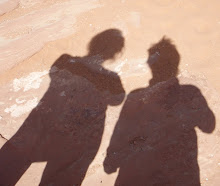Anyway, Will used to be a volunteer up at Cleland, so he volunteered to be our guide for the day. Cleland is one of a string of National Parks along western side of the Adelaide Hills—in this case, the entrance to Cleland is just a few kilometers from the summit of Mt. Lofty. We tried stopping at the summit on the way in, but it was still shrouded in fog. Fog in the summer is a good sign, because it means there is a lot of moisture in the air and it will be raining soon somewhere, probably in the Hills in a place like Blackwood, where we live.
And that’s what we did. Starting with the Tasmanian Devil in his enclosure. Apparently the ‘devil’ part comes from the sound that they make, but they look quite friendly, aside from the massively overdeveloped jaws. There is a strong effort to create a genetically viable population on mainland Australia due to the spread of facial tumor disease through nearly the entire Tasmanian population. The spread of devil facial tumor disease is handily aided by the fact that Tasmanian Devils greet one another with bites to the face. Whatever benefit that particular habit has, it seems to have come face-to-face with natural selection (no pun intended).
Without a doubt, the highlight of the day was the kangaroos. Most kangaroos are quite wary of humans, but those at Cleland are quite used to our sort, so much so that our first up-close contact with a kangaroo was when one hopped over toward us to check us out. The kangaroos were actually interested in our feed bags, but it suited us all the same, because we were hand feeding them, which was great. They are sort of like Tyrannosaurus Rex with their tiny little arms. It was so cute, though, because they would put their mini little paws on your hand and then eat right from it. One scene that wasn’t cute at all was this very big, old, slow, male kangaroo that kept trying to mate with this very small, young female. He would take these very slow laborious steps towards the young female, and just as he would reach out his arms to her, she would take just a few, quick hops just out of reach. He would again slowly make his way to her, only for her to hop just out of reach.
The birds at Cleland were quite varied. In addition to birds we had already encountered in Australia (like ducks, egrets, and pelicans), there were also Cape Barren Geese with their green bills, human-sized emus, and lots of Superb Fairywrens, which are bright blue and wiggle their tails back and forth very quickly. This behavior has won them the common Australian name of “Willy Wag-tail.” It's a bit tough to photograph a fairywren because they are so small and fast.
We saw lots of other animals including wombats, echidnas, dingoes, koalas, and even a numbat. Wombats look a bit like capybaras and are pretty solid. However, modern wombats are actually the miniature version--one of the classic members of the now-extinct Australian megafauna is Diprotodon, which is essentially a wombat larger than a buffalo (!). On the other hand, a numbat looks nothing like a wombat—it is probably about 1/50th of the mass of a wombat and is actually quite a delicate little rodent. They are actually extinct in the wild in South Australia, like a number of other endemic Australian species. Chelsea thinks their extinction may have had something to do with their name, which really sounds like a combination of numbskull and dingbat. One of my favorite animals was the Spinifex hopping mice, a desert rodent that lives in the protection of the sharp spinifex plant. The spinifex plant (and the mice) are unique to Australia, and inspired the ‘spinifex texture’ that characterizes many komatiites (more on spinifex and komatiites in a future post).

Hmmm, you might check the reference to Willy. I think that is a separate species from the fairy-wren.
ReplyDeleteI don't think we saw the T. devil when we were there. So I am jealous.
And the kangaroos are a sight to behold. I never got used to seeing them or marveling at their anatomy. They are so different from anything we see here in the USA.
And what are chances you would meet someone there from Minnesota. Ahh, the wonders of Ultimate...